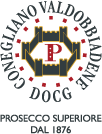SWEET HILLS AND LUSH VINEYARDS
The hills that extend from Conegliano to Valdobbiadene have been embellished for centuries with vineyards designed with geometric precision and cultivated by very skilled hands. Conegliano is a small city with an ancient history made up of castles and agricultural landscapes that have been very well preserved over the years and centuries. Conegliano is surrounded by a breath taking background made of gentle hills and lush vineyards that extends up to San Pietro di Feletto.
Old papers, dating back to the 12th century AD prove that the wines of the Conegliano hills were very popular and appreciated in Venice and in the courts of Europe. And the most interesting wine production areas were those of the Felettano area.
This amazing green and fruitful area, with mainly southern exposure, is particularly suitable for viticulture thanks to the mild and temperate climate as well.
It is a true masterpiece of nature, so much that several artists reproduced this breath taking landscapes in their works.
Conegliano and Valdobbiadene: since the ancient Roman times these hills have been embellished century after century with vineyards designed with geometric precision and have been cultivated by skilled hands. Conegliano, city with an old history, made of castles and agrarian landscapes, has preserved its charme until today. It is surrounded all around by gentle hills and lush vineyards which extend uninterrupted up to San Pietro di Feletto. According to official papers dating back to the twelfth century AD, the wines of the „Colli di Conegliano“ were in great demand and were very much appreciated in Venice and in all courts of Europe.
The most interesting production areas at the time were those of the so called „Felettano“. This area, know especially for its beautiful sweet hills has been always particularly suitable for vthe viticulture, due to the conformation and constitution of the soil, to the mostly southern exposure of the hills and to the mild and temperate climate. A true masterpiece of nature, very much loved by lots of artists who represented glimpses of this admirable landscape in their works.
The city of Conegliano is the historical capital of „Prosecco“ as well as of the real capital of viticultural and oenological research. It was here that in 1603 the Academy of Aspirants was founded. It became then in 1769 the Academy of Agriculture according to the wishes of the Republic of Venice. The “Treviso Wine Society” was born in 1868 and was transformed into the Royal School of Viticulture and Oenology in 1876 (first in Italy). The school would change its name in 1923 into „the Experimental Institute for Viticulture“, the Italian hub of scientific updating in terms of viticulture.
CONSORTIUM FOR THE PROTECTION OF PROSECCO WINE

On June 7th, 1962 the “Consortium for the Protection of Prosecco Wine” of Conegliano and Valdobbiadene was established within this important scenario which is becoming increasingly promising for the wines of the area. The Consortium works to maintain, guarantee and improve the quality of Prosecco D.O.C.G and to spread its knowledge and image in Italy and abroad. The historic brand of the consortium protects the quality of Prosecco di Conegliano and Valdobbiadene. The Ceschin Giulio company is member of this consortium, believing and supporting its rules and its purposes of protecting the best quality of Prosecco wine. In this way we want to offer consumers an additional guarantee of authenticity.
Conegliano e Valdobbiadene
dolci colli e rigorosi vigneti
Conegliano and Valdobbiadene: since the ancient Roman times these hills have been embellished century after century with vineyards designed with geometric precision and have been cultivated by skilled hands. Conegliano, city with an old history, made of castles and agrarian landscapes, has preserved its charme until today. It is surrounded all around by gentle hills and lush vineyards which extend uninterrupted up to San Pietro di Feletto. According to official papers dating back to the twelfth century AD, the wines of the „Colli di Conegliano“ were in great demand and were very much appreciated in Venice and in all courts of Europe.
The most interesting production areas at the time were those of the so called „Felettano“. This area, know especially for its beautiful sweet hills has been always particularly suitable for vthe viticulture, due to the conformation and constitution of the soil, to the mostly southern exposure of the hills and to the mild and temperate climate. A true masterpiece of nature, very much loved by lots of artists who represented glimpses of this admirable landscape in their works.
The city of Conegliano is the historical capital of „Prosecco“ as well as of the real capital of viticultural and oenological research. It was here that in 1603 the Academy of Aspirants was founded. It became then in 1769 the Academy of Agriculture according to the wishes of the Republic of Venice. The “Treviso Wine Society” was born in 1868 and was transformed into the Royal School of Viticulture and Oenology in 1876 (first in Italy). The school would change its name in 1923 into „the Experimental Institute for Viticulture“, the Italian hub of scientific updating in terms of viticulture.

On June 7th, 1962 the “Consortium for the Protection of Prosecco Wine” of Conegliano and Valdobbiadene was established within this important scenario which is becoming increasingly promising for the wines of the area. The Consortium works to maintain, guarantee and improve the quality of Prosecco D.O.C.G and to spread its knowledge and image in Italy and abroad. The historic brand of the consortium protects the quality of Prosecco di Conegliano and Valdobbiadene. The Ceschin Giulio company is member of this consortium, believing and supporting its rules and its purposes of protecting the best quality of Prosecco wine. In this way we want to offer consumers an additional guarantee of authenticity.







